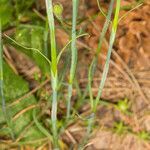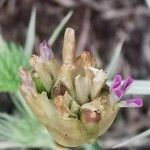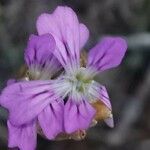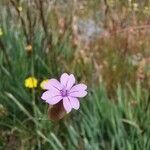Herb, annual, glabrous or partly tomentose. Stem erect, simple or branching from base, to 50 cm tall; internodes glabrous. Leaves sessile, linear, acute, 10–70 mm long, c. 2 mm wide; sheaths less than twice as long as wide. Inflorescence a dense, terminal cluster of flowers; bracts blunt or only the outer mucronate, concealing calyces. Pedicels to c. 0.5 mm long. Calyx 10–14 mm long; calyx lobes short, obtuse, membranous. Petals 10–13 mm long, 2–3.5 mm wide, pink or purplish, ± emarginate. Styles 2. Capsule elliptic-ovoid, c. 6 mm long. Seeds 1.3–1.6 (–1.8) mm long, brownish black, ± cucullate, bluntly striate-tuberculate.





